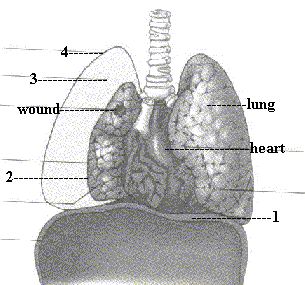The
questions are specific to the current class textbook. Other publications may
have other answers.
Quiz 5
Name:
Date:
Return E-Mail (if applicable)

Label the pleural surfaces
1.(muscle)
2.
3.
4.
5. List the three common medical conditions associated with COPD.
6. What is the term given to an asthma attack which cannot be broken with
conventional treatment.
Number 7 through 24: Match the following signs and symptoms to the most
likely disease or condition.
a. Emphysema (used 2 times)
b. Chronic Bronchitis (used 2 times)
c. Asthma (used 3 times)
d. Spontaneous Pneumothorax (used 1 times)
e. Pulmonary Embolism (used 3 times)
f. Hyperventilation Syndrome (used 3 times)
g. Pulmonary Edema (used 2 times)
h. Pneumonia (used 2 times)
7. Can
develop quickly after an MI
8. May
be caused by severe emotional stress, exercise or respiratory infections
9. The
natural inflation of the lung are lost
10. Smaller
airway constriction which may be reversible
11. After
surgery or immobilized people is more common
12. May
be seen with left sided CHF
13. Blue
bloater
14. Rapid
onset with significant dyspnea
15. Allergen
may be the trigger
16. Dyspnea
which occurs in a patient with no lung disease
17. Usually
associated with fever, and production of sputum
18. Result
of a lack of carbon dioxide in the body
19. Pink
puffer
20. Occlusion
by a blood clot
21. Alveoli
damage
22. Excessive
mucous production in the bronchial tree
23. Anxiety,
dizziness, numbness, carpal/pedal spasms
24. May
develop in patients who do not fully inflate their lungs routinely
Match the definition with the term. (May be used only once)
25. Dose
26. Action
27. Indication
28. Contraindication
29. Trade
name
30. Generic
Name
a. Would be harmful if given b. Amount to be administered
c. What the drug does d. Chemical name
e. When to give a drug f. Begin with capital letter
Match the administration routes (may only be used once)
31. Intravenous
(IV) 32. Oral
(PO) 33. Intramuscular
(IM)
34. Intraosseous
(IO) 35. Subcutaneous
(SQ)
36. Sublingual
(SL)
a. Needle at a 90 degree angle
b. Fastest and most reliable route
c. Needle at 45 degree angle
d. Used most commonly on small children
e. Mucous membranes
f. Digestive system
37. Activated charcoal and MDI are what form of medications?
Number 38 through 57: Match the drug with the correct information
a. Epinephrine (used 4 times)
b. Oral Glucose (used 2 times)
c. Albuterol (used 3 times)
d. Oxygen (used 3 times)
e. Nitroglycerin (used 6 times)
f. Activated Charcoal (used 2 times)
38.0.5
to 1g per kg (talked about this in class as being more accurate
for this med)
39.2.5mg/3mL
40.1
to 45LPM 41.25
to 50g
42.0.4mg
43.0.3mg
44.0.15mg
45.SL
46.Chest
pain 47.Low
sugar 48.Initial
drug for dyspnea
49.SOB
& low BP 50.90mcg
single dose 51.Gas
52.May
repeat once if pt vomits 53.May
give up to 3 doses
54.May
have to repeat in 20 minutes 55.beta2
stimulant
56.Headache/bitter
57.
Lowers BP
58. Define the term ischemia.
59. Define the term lumen.
60. Define the term infarction.
Pick the most likely sign and symptom for the following medical
conditions. (Keep in mind that all s/s may happen in both in
the "real world")
a. Acute MI b. Angina Pectoris
61.
Pain usually decreases with 15 minutes of rest
62.
Wakes the patient out of a sleep
63.
Spasm of the coronary arteries
64.
Blockage of the coronary arteries
65.
List 8 common signs and symptoms of someone having an MI.
66. What is the most common cause of left sided CHF.
67. What is the most common cause of right side CHF.
68. At what minimum age can the adult pads of an AED be used?
Define the terms
69. Bradycardia
70. Tachycardia
71. Pedal edema
72. Syncope
73. Ventricular fibrillation
74. List the two most common error when using an AED that are preventable.
75. List two ways a stroke can develop in the brain.
76. List three signs and symptoms of a stroke.
Match the choices to the medical condition
77.
Grand mal seizure
78.
Petit mal seizure
79.
Focal seizure
a. Typically occurs in young children
b. Last from 45 seconds to 2 minutes. No breathing
c. Involving only a specific area of the body
80. What is the term given to the period right after a seizure?
81. What is the term given for repeated seizures without regaining
consciousness?
82. What is the most common reason for seizures in children?
83. What is the most common reason for seizures in adults?
